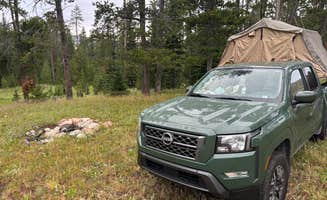Dispersed camping near Fort Smith, Montana primarily centers around Bighorn Canyon National Recreation Area and surrounding Bureau of Land Management (BLM) lands. Winter camping offers unique solitude with temperatures frequently dropping below freezing, particularly from November through March. The Crow Indian Reservation borders much of the public land, requiring campers to verify boundaries before setting up.
What to do
Fishing at backcountry sites: Backcountry camping along Bighorn Lake provides excellent fishing access in less crowded areas. At Bighorn Canyon National Recreation Area, campers can target trout and walleye year-round, with prime fishing occurring during spring and fall.
Wildlife viewing opportunities: Early morning and dusk offer prime wildlife viewing at forest-edge campsites. "During the evening, we saw a large herd of Elk on the forest perimeter," notes a camper at Meadow Camp on Forest Road 231.
Water-based recreation: Many dispersed sites allow direct water access, though conditions vary seasonally. "Amazing views" are available from waterfront camping at Big Horn NRC Dispersed SR, where kayaking and canoeing are popular during summer months when water levels are stable.
What campers like
Off-grid experience: The remote nature of sites appeals to those seeking true disconnection. "Great experience! Off the grid campsite with no service or bathrooms. Fireplaces set up at the sites," reports Kale R. at Schuler Park, highlighting the rustic camping experience near Fort Smith, Montana.
Spacious campsites: Many dispersed areas offer ample room between campsites. At Gravel Pit Dispersed Camping, Robert B. notes, "Great area with trees and wildlife. Spots for campfires, and plenty of space. You can get multiple groups of people in here."
Natural surroundings: The undeveloped terrain provides genuine wilderness camping. Campsites near Big Horn NRC feature minimal human impact and offer unobstructed night sky viewing thanks to minimal light pollution.
What you should know
Road conditions vary dramatically: Many access roads deteriorate quickly after rain. "Dirt road to the sites but it is in good condition," mentions a reviewer at Schuler Park, but this can change seasonally.
Closures may occur without notice: Always check current status before heading out. "The only entrance off the highway was closed and there was no sign explaining why," warns Steve M. about his experience trying to reach General Custer Fishing Access Road.
Extreme temperature swings: Daily temperature fluctuations of 40+ degrees occur regularly, particularly in spring and fall. Pack accordingly for both hot days and near-freezing nights, even during summer months.
Wildlife precautions required: Bear-safe food storage is necessary at all dispersed sites. Proper food storage requires hanging supplies at least 10 feet high and 4 feet from any tree trunk.
Tips for camping with families
Bathroom planning essential: With no facilities at most sites, prepare accordingly. Robert B. notes at Gravel Pit Dispersed Camping: "No bathroom so you'll be going in the woods unless you drive to a picnic area."
Bug protection critical: Insect populations can be overwhelming in certain areas. One camper at General Custer Fishing Access Road warns: "The mosquitoes here are horrid as it's a marsh, we considered peeing in a jar in our van instead of risking opening the insect mesh."
Select sites with natural boundaries: For families with younger children, look for sites with natural features that create defined spaces. Big Horn NRC offers several spots where rock formations or vegetation create natural play areas while maintaining sight lines for supervision.
Water access considerations: Waterfront sites require extra vigilance with children. Sites near Bighorn Lake feature steep drop-offs that can be dangerous for inexperienced swimmers.
Tips from RVers
Site selection crucial: Many dispersed sites have limited level areas for larger vehicles. "Easy access off Hwy 14. Was busier than expected with lots of 5th wheelers but spaced out enough that we had privacy," notes J C. about Meadow Camp on Forest Road 231.
Access road challenges: Narrow roads with vegetation can damage vehicles. At General Custer Fishing Access Road, one camper reports: "One of which requires running a gauntlet of overgrown willow bushes and scratching a substantial amount of paint off the sides of your vehicle to access."
Limited turnaround space: Scout sites before committing, particularly with trailers. Several areas near Bighorn have limited space for turning around larger rigs once you've entered the access roads.


